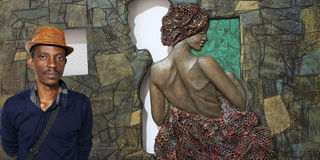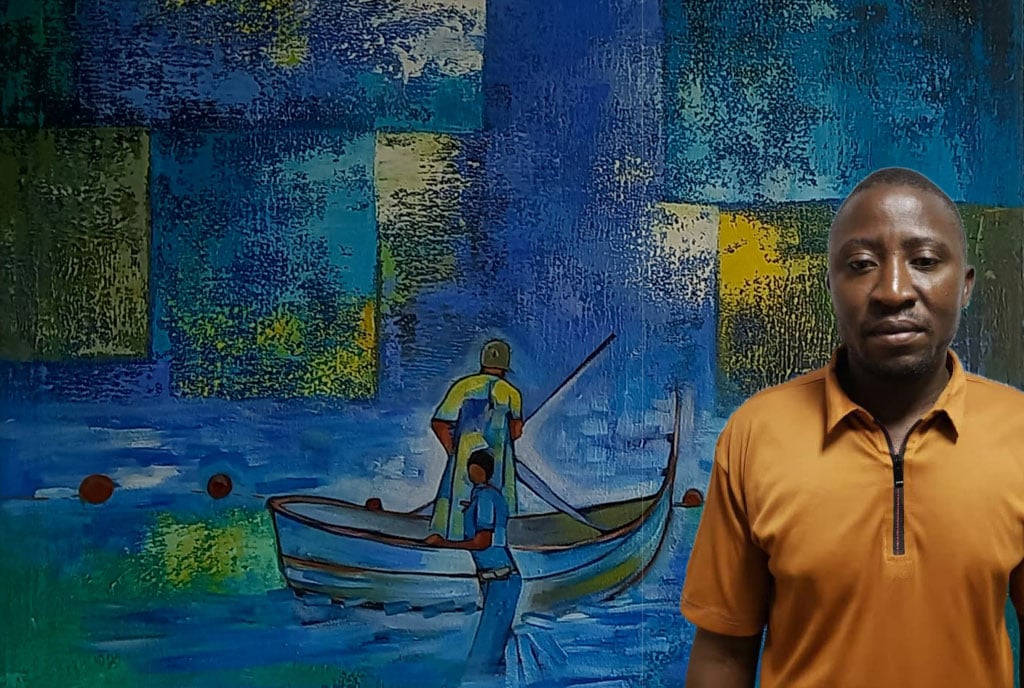Prime
Art is actually a burden–Ronex

Ronex Ahimbisibwe’s art is a mix of oil on canvas and collage such as metal, cloth and newspapers among others. PHOTOs/Andrew Kaggwa
What you need to know:
Monumental. He’s one of Uganda’s most experimental artists, working with a range of mediums and styles. Ronex is a sculptor though he’s known to many for his painting and installations
“Sometimes people see an artwork and believe that the money they see quoted on the painting in the gallery is what the artist will get. But the truth is that some galleries take 40 percent of that, and some will want the artist to use what he gets to fund the transportation of the work to the client,” says Ronex Ahimbisibwe.
Ahimbisibwe is a semi-abstract artist who experiments with everything from material, technique, framing, and wielding. Initially, he says he majored in sculpture, but most people know him for his paintings.
In 2022, Ahimbisibwe celebrated 20 years as a creative artist with three exhibitions at the Makerere University Margaret Trowell Art Gallery, Xenson Art Space, and Umoja Art Gallery. The exhibition opened in the three locations on the same day, starting in Makerere and concluding in Umoja.
At the moment, he is holding a continuation of those exhibitions, a collection of his 20+ years of artwork, and a few new ones. Unlike in 2022, this one is solely taking place at Umoja Art Gallery’s new location in Bukoto.
After being an artist for 22 years, Ahimbisimbwe has definitely experienced the ups and downs of being creative in Uganda. He says, for instance, that being an artist means venturing into murky waters, especially when it comes to dealing with middlemen in business.
“There is a lot of politics with collectors; some of these will come and collect a lot of art works from people they believe are promising. We are talking about buying works for $250 and later selling them for $1000. It is always depressing when an artist learns of the price their work was sold at. The most depressing thing is that most collectors buy in bulk; they will buy about twenty to ten works whose price will keep appreciating without them ever needing the artist in years,” he says.
Ahimbisibwe’s journey into art started in 2002; at the time, he says there were just a few spaces an artist would sell work in: Tulifanya. Every artist that graduated wanted to get their work to Tulifanya, but the window was so small.
Beverly Paden, a Canadian artist and collector, established Tulifanya in 1995. Being the only private gallery in the early 2000s, every artist tried to have their works in the gallery.
The passion
Ahimbisibwe was one of these artists.
He says, “Tulifanya rejected me a lot of times, but I consider rejection a part of creating; it takes years to get it right.”
He says that he believed that people would only consider him an artist if he had a solo exhibition; thus, he knew that he needed Tulifanya, and the rejection did not phase him.
“Having an exhibition for me means a lot; it means someone is taking a risk on you and your work,” he says.
Ahimbisibwe has been opening the exhibition circuit in Kampala for many years; then he would exhibit at Afriart when it was still in Kamwokya, though over the years, with more spaces, he has more choice with venues.
Sometimes he will have an exhibition at Afriart in the industrial area or on the other side of the city, at Xenson Art Space in Kamwokya, or at Umoja in Bukoto. This year, he even plans to take them as far as Masaka.
Most times, he says he spends at least six months with his work; the belief is that at that time, he is convinced the work is nearly done. But still, that work is not signed; as long as it is still in his studio, he believes it is a work in progress and can add things to it.
“When the artwork goes to the gallery in an exhibition, that’s a complete artwork,” he says.
He still exhibits some of his works without a signature or hidden signatures; he says not signing works is a way of not biassing the audience. “I want to see how people react to the work without knowing who did it. I believe if people love it, they will try to look for the signature; if they don’t care to know, maybe the work isn’t good enough; maybe it’s not really powerful.”
A burden
Ahimbisibwe has been practising long enough; he has accumulated a lot of work and, in the same way, has exhibited numerous times. However, even though he majored in sculpture, he has not held a strictly sculpture solo exhibition.
“Sculpture always comes with a crisis of storage,” he says, adding that he is mostly known for painting because paintings do not take up a lot of space after exhibitions.
“Most of the time, curators ask us to do installations and never ask themselves where the work goes when the exhibition is done,” he says.
Ahimbisibwe says that when they exhibit, the works sold are always fewer than those that stay behind, and most artists struggle with keeping these works safe. Because of such reasons, many have lost work worth millions because of storage issues.
“Most of the work we do is a portion people buy; the percentage that stays behind becomes a burden,” he says.
After that, he says they have to deal with bulky art work they at times have no idea what to do with, it becomes worse if their studios are not big enough.
“Most people think that art is a blessing, but it is also a burden. Storage is a problem for every artist doing it professionally,” he says.
He shares that many times, after exhibitions, galleries often struggle to get artists to pick their works in vain.
“If you are to visit any gallery in Kampala, you will definitely find them stranded with work artists refused to pick up after an exhibition; most of them don’t know where to keep the work,” he says.
Ahimbisibwe’s home is also his studio, so he says that he has reshaped much of it to be able to keep his works; for instance, his ceiling is storage, as are some of his sculptures. “Whenever I am creating a sculpture, I always make sure that I can also use the work as storage for smaller works,” he says.
But this has not secured all his works; some of them were eaten by rats and ants; he was forced to cut them and use them as collage for his newer works.
“Very many artists were disappointed by the fact that I cut my work, but the situation led me to that. I also look at it as giving this work new life when I used it to make newer creations,” he says.




